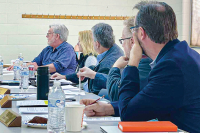National treasure: National Park Service celebrates 100 years
When President Woodrow Wilson scrawled the signature that brought the National Park Service into being — 100 years ago, on Aug. 25, 1916 — many of the parks now integral to America’s national identity had yet to be created.
SEE ALSO: Thousands of acres added to the Parkway for Park Service centennial
There was no Great Smoky Mountains National Park, no Blue Ridge Parkway, no Appalachian Trail. No Grand Teton or Olympic or Mammoth Cave or Acadia National Park. At the time Wilson signed the Organic Act, only 35 national parks and monuments existed, with America the only country to have any.
Messages to the future: Park Service, outdoor camp work to mold diverse new generation of outdoor enthusiasts
The air on the Cataloochee Divide Trail is heavy with humidity and the promise of an afternoon storm, but the pervading mood is contrastingly buoyant as a group of 27 teens and their leaders sets out on a sunny Thursday morning.
It’s a tone that Cassius Cash, superintendent of the Great Smoky Mountains National Park, had set before anybody left the trailhead.
Locally shot, genre-bending sci-fi thriller draws inspiration from the region
The presence of breathtaking topography, ancient native lore, and centuries of American history makes the Great Smoky Mountains a mystical, mysterious place as ominous and foreboding as it is inviting and encouraging.
SEE ALSO:
• Filming in the Great Smoky Mountains National Park
• Haywood County to filmmakers: We’re ready to rollWe’re ready to roll
These conflicting spirits also make the region a haven for filmmakers, including the cast and crew of the recently released, locally shot feature film “Beacon Point.”
Voting contest yields funds for Smokies tower restoration
 Clingmans Dome Observation Tower will get a makeover thanks to a $250,000 grant that supporters of the Great Smoky Mountains National Park landed through participation in an online voting contest.
Clingmans Dome Observation Tower will get a makeover thanks to a $250,000 grant that supporters of the Great Smoky Mountains National Park landed through participation in an online voting contest.
Shelter at bear attack site now open
 Nearly a month after an Appalachian Trail thru-hiker found his night interrupted by an attacking bear, the backcountry shelter in the Great Smoky Mountains National Park where the incident occurred is open once more.
Nearly a month after an Appalachian Trail thru-hiker found his night interrupted by an attacking bear, the backcountry shelter in the Great Smoky Mountains National Park where the incident occurred is open once more.
Park proposes fee hike for campgrounds
 Camping fees could increase in the Great Smoky Mountains National Park if a recently released proposal gains approval.
Camping fees could increase in the Great Smoky Mountains National Park if a recently released proposal gains approval.
A strained relationship: Suspicion of NPS lingers among some backcountry users, parkside communities
 It’s been three years since a vigorous debate about charging for backcountry camping in the Great Smoky Mountains National Park ended with the park’s decision to charge backpackers a $4 fee, but for the fee’s most stalwart opponents, the issue isn’t yet in the rearview mirror.
It’s been three years since a vigorous debate about charging for backcountry camping in the Great Smoky Mountains National Park ended with the park’s decision to charge backpackers a $4 fee, but for the fee’s most stalwart opponents, the issue isn’t yet in the rearview mirror.
Southern Forest Watch, a group that formed expressly to fight the fee, filed suit against the National Park Service soon after the fee was approved in February 2013. The public had overwhelmingly decried the proposal, SFW said, arguing that the park hadn’t followed correct procedure when approving it and contending that the assertion that the existing backcountry system was inadequate, crowded and causing complaints — necessitating the fee — was unfounded.
A double-edged sword: Rising visitation in the Smokies brings challenge and reward
 Lynda Doucett and her staff at the Great Smoky Mountains National Park were pretty excited to move into the new Oconaluftee Visitor Center when it opened back in 2011. The staff on that side of the park had been stuffed into the tiny little “temporary” visitor center next door in the old administration building since 1948, so the brand new $3.5 million building was definitely going to be an upgrade.
Lynda Doucett and her staff at the Great Smoky Mountains National Park were pretty excited to move into the new Oconaluftee Visitor Center when it opened back in 2011. The staff on that side of the park had been stuffed into the tiny little “temporary” visitor center next door in the old administration building since 1948, so the brand new $3.5 million building was definitely going to be an upgrade.
But the 2011 move involved change beyond increased floor space and better interpretive displays. The more impressive building enticed more of the visitors driving by to stop in, and because the timing coincided with an overall surge of visitation in the park, there were more passerbys overall.
Reducing their footprint: Smokies unveils new energy-efficient equipment
 The Great Smoky Mountains National Park marked a milestone last week with the unveiling of 10 new pieces of equipment to make transportation in the park more energy-efficient.
The Great Smoky Mountains National Park marked a milestone last week with the unveiling of 10 new pieces of equipment to make transportation in the park more energy-efficient.
A project four years in the making, the new purchases — made using a $239,000 grant — are just the first phase in a three-year plan to reduce emissions in the park.
Agencies join forces to address elk concerns
 Elk and humans are still trying to figure out how to cohabitate in Western North Carolina since the herd was re-introduced to the Cataloochee Valley in 2001.
Elk and humans are still trying to figure out how to cohabitate in Western North Carolina since the herd was re-introduced to the Cataloochee Valley in 2001.





